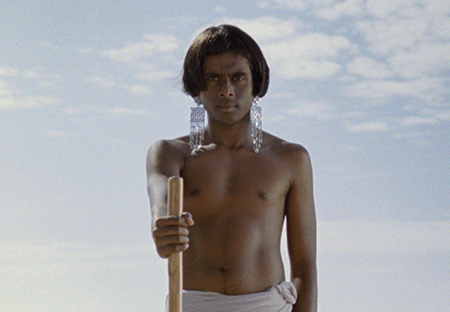Haris Epaminonda

In late 2013, the New Yorker art critic Peter Schjeldahl wrote of the ‘art-historical amnesia’ of much contemporary art, suggesting the term ‘Neo-Mannerism’ to describe artists who recycle generic styles without wanting to acknowledge tradition or influence. While at first glance Haris Epaminonda might be lumped in with other high-profile young artists who promote this sense of rootless nostalgia, a closer look reveals someone genuinely engrossed in the landscapes and mythologized history of her native Cyprus. Having encountered her exhibition, ‘Chapters’, after visiting Nicosia’s beguiling archaeological museum, I was immediately struck by Epaminonda’s preoccupation with Cyprus’s art-historical identity – an aspect of her work that can seem obscured by exoticism when shown outside of its local context.
Developed by Point Centre for Contemporary Art in collaboration with Kunsthaus Zurich, Fondazione Querini Stampalia and Modern Art Oxford, the exhibition’s title derived from Epaminonda’s video installation Chapters (2013), displayed on the upper level of the gallery. Comprising four asynchronous digital video projections converted from 16mm film, each running for about an hour, Epaminonda configured her projected images around the darkened maze-like space to appear both connected to and cut off from one another. The arrangement generated different juxtapositions over the course of the exhibition, giving the installation a fragmented quality, and yielding a mysterious sense of incompleteness common to almost all of the artist’s serial-driven work.
Purportedly inspired by an eclectic range of undisclosed myths, Chapters exploits the evocative landscapes of Cyprus, utilizing sets and paraphernalia made by local collaborators, including many from the Cyprus Theatre Organisation. In one scene, a black woman dressed in a white dress stands in a stone interior passively facing the camera as a man wearing gold trousers and white make-up performs a choreographed ritual, waving a large feather and what appears to be a miniature devil’s pitchfork. This engrossing and subtly comic scene plays out whilst another projection depicts clouds passing over the moon during daylight; another repeatedly shows a closely-framed scene of a Japanese woman in a silk robe facing away from the camera before slowly turning to face it, vaguely referencing Kabuki theatre.
The work’s saturated colours, desert imagery, abstract mythological references and geometric cinematography recalls Chilean filmmaker Alejandro Jodorowsky’s The Holy Mountain (1973) and El Topo (1970), but not in the tokenistic way that is so often encountered in contemporary video art. The control that Epaminonda wields over her imagery places her on equal footing with the acclaimed director, while also bringing to mind sequences in films by cinematic greats such as Andrei Tarkovsky and Sergei Parajanov. Adding to its cinematic affect, the atmospheric soundtrack – specially composed by the British duo Part Wild Horses Mane On Both Sides – features cymbals and reverbed field recordings that are perfectly attuned to Epaminonda’s traversing of auteurist cinema, New Age spiritualism and conceptualist video art.
On the ground floor of the gallery, Epaminonda’s sparse installation of thin, black minimalist-style structures, white picture frames, antique pottery, museum plinths and Cyprian archaeological imagery was masterfully understated, revealing the far-reaching cultural perspectives underpinning her work. Part of the series ‘Volumes’ (2009–ongoing), the installation metaphorically conflated the museum and its collection, presenting museological analysis as if it were just one narrative in the potentially long history of a collected object. This concern for history was the poetic thrust of the exhibition, and reflected the scope of Cyprus’s artistic heritage – which spans the rise and fall of ancient Eastern and Western regimes. Coming from the Greek side of the divided city of Nicosia, Epaminonda transforms her home country into a backdrop for a multitude of mythological identities, working against Schjeldahl’s ‘art-historical amnesia’ to portray art-making as a kind of enigmatic social ritual.
















